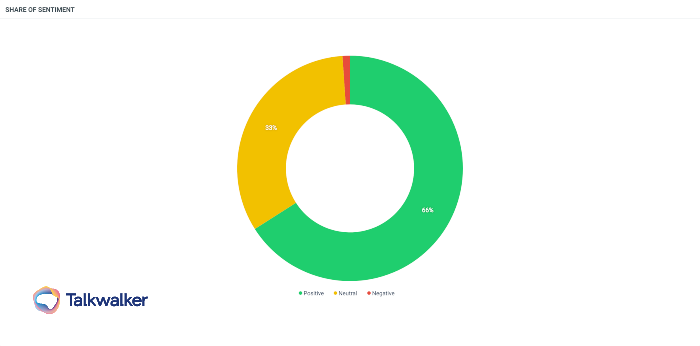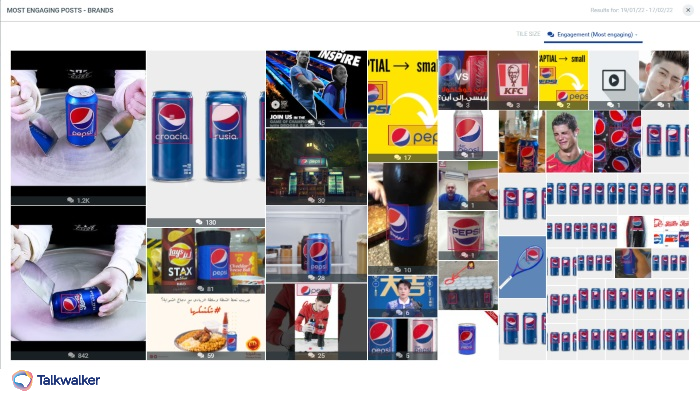Talkwalker and Twitter published their latest report on the global food industry.
The F&B industry has long been the subject of scrutiny in the Middle East, especially with countries like Kuwait, Saudi Arabia, and Qatar topping the lists for most obese countries per capita. All members of the value chain are working towards promoting a healthier lifestyle, encouraging better eating habits, and raising awareness of the importance of physical wellness.
Middle East consumers are developing an appetite for new international foods, flavors, and tastes, which have become accessible due to globalization. During the early days of the pandemic, expats in the region wanted to have a taste of home - recreating some of the recipes they learned through WhatsApp calls with family. It’s also important to note that consumers became increasingly curious to try new recipes at home that under normal circumstances, they wouldn’t have tried.
The food industry trends in the Middle East are driven by increased choices and options, social media, government-supported awareness campaigns, and eco-conscious consumption. During Gulfood 2022, the largest expo for the Middle East food industry, F&B brands showed that they recognize consumers' needs for healthier, sustainable, and nutritious food.
Birdseye Report: Food
Talkwalker and Twitter have recently published the ‘Birdseye Report: Food’ that taps into the global food industry as it inspires change and disrupts the status quo. The insights in the report rely on data from consumer conversations happening around topics like sustainable packaging, healthy foods, and alternative proteins, among others.
The food and beverage industry in the Middle East is actively promoting its ESG credentials. Middle East consumers want to know where their food comes from, whether it’s fairtrade or not, and its impact on the environment. One of the insights from the report is that consumers are becoming more conscious about the carbon footprint of the food they eat.
F&B brands in the Middle East, as well as restaurants and hotels, are in the process of ditching single-use plastic food packaging, and instead opting for sustainable, compostable, and even edible packaging.
Our Food Industry Trends report with Twitter also reveals data on the rise of alternative proteins and how takeout food will become a staple of every modern family’s diet.
Learn about the latest food industry trends in this report
The food industry in the Middle East could rely on already existing market trends to develop new products that match consumers' needs, such as iron deficiency, weight loss, and food safety.
Food industry trend: People eating at home
The food and beverage industry in the Middle East is adapting to the new hybrid lifestyle of consumers. The hybrid lifestyle, imposed by COVID, meant that consumers were balancing eating in and out.
This ‘balancing’ method could be seen by the increased popularity of online grocery shopping and ordering ready-made healthy meals. Also, traditional F&B brands that long relied on traditional distribution models had to upgrade their digital capabilities in order to stay in the competition.
According to the Dubai Chamber of Commerce and Industry, online F&B sales saw 255% growth in the UAE in 2020, to hit $412M with an 8.5% CAGR, to reach $619M by 2025. Also, according to the same report, F&B trade in the UAE increased steadily to reach over $20 billion in the first nine months of 2021.
Throughout the pandemic, Middle East consumers became aware of their expenses, weighing the value equation between the cost of eating at home versus the cost of eating out. This is a new reality that the F&B industry is adapting to by embracing new Q-commerce models through delivery partners like Deliveroo, Careem, Zomato, Toters, and Carrefour. Another model adopted by the F&B industry is the subscription model which allows consumers to only pay for the items they choose to keep from a delivered package (bundling).
It is anticipated that companies that have exposure to consumers at home and outside the home will generally perform better. For example, brands like Pepsico, Kraft-Heinz, and Masafi are in a much better position to reach consumers wherever they are: at the restaurant, on a flight, at home, or even at the gym.

Top themes surrounding online food delivery in the Middle East during the past year.
Download the Birdseye Report: Food report
Food industry trend: Consumer appetite for healthier foods
Middle East consumers have long embraced non-alcoholic beverages as their go-to drink at bars and restaurants. However, even consumers who have long consumed alcoholic beverages are making the switch towards the healthier alternative.
In fact, there are more brands jumping on the wagon than off, such as Heineken and Corona. The Bacardi cocktail trend for 2022 found that 58% of global consumers are drinking more non-alcoholic beverages (or low alcoholic beverages) than a year ago at 47%.
Diageo’s Future of No and Low report stated that there’s an emerging trend of using ‘mixers from foraged flora and fauna as well as soft pairing menus.’
There is also an emerging food industry trend in the Middle East, specifically around mushrooms. After a year of the cauliflower craze, mushrooms are becoming popular among health-conscious eaters. Given that mushrooms are easy to grow and have a high yield, they are posed to be a key crop, especially as they require very little space and water.
Furthermore, mushroom fiber has seen increasing popularity in other non-food-related uses such as cheap compostable packaging. Mushroom fibers took center stage at the last CES in Las Vegas where Mercedes Benz showcased a concept EV where the seats were made from mushroom fibers.
Middle East consumers’ pursuit for health and wellness reaches the realms of biohacking and superfood diets. Though, it is evident that Middle East food consumers are becoming much more aware of what they put in their kitchens and eventually their mouths.
The sentiment of conversations around ‘mocktails’ is generally positive in the Middle East during the past year.
Download the Birdseye Report: Food report
Food industry trend: Prices of food items going up
There are several factors affecting the price of food items globally. Firstly, there’s the ongoing supply chain issue that is limiting the number of foods being exported or imported. Furthermore, food is costing more to produce given the record-high prices of energy and the volatility that is caused by climate change, floods, drought, and locusts. The lack of laborers is affecting the global food supply to a lesser extent, though it is being overcome by automation.
In the Middle East, a region scarce in freshwater, food manufacturers are embracing sustainable agri-tech solutions or vertical farming to mitigate some of the risks associated with the aforementioned element.
Rising prices are impacting consumers’ grocery habits. Middle East consumers are increasingly looking for discounts like buy-one-get-one (bogo) deals, buying in bulk, or buying long-shelf items.
Convenient ready-to-eat foods that have a relatively long shelf-life are projected to witness a CAGR of 2.8%, during the five years.
Download the Birdseye Report: Food report
Middle East food industry to grow more with mergers and acquisitions
Early during the pandemic, F&B brands kept their cash close in anticipation of what would happen in terms of lockdowns. However, now that the pandemic is almost over, F&B brands in the Middle East are actively consolidating their margins after an unstable year.
For example, Abu Dhabi-based Agthia continues to expand its portfolio of brands under its umbrella after its recent finalization of acquiring regional healthy snacks pioneer BMB Group. Another major move in the regional F&B industry is when Saudi-dairy giant Almarai completed the acquisition of Bakemart’s businesses in the UAE and Bahrain in a deal valued at 93.5 million dirhams ($25.4 million).
Download the Birdseye Report: Food report
Food and beverage brands must be aware of continuously evolving consumer needs and expectations. Real-time consumer intelligence enables F&B brands to reveal why consumers behave in a certain way, and what drives them to make those decisions. The transition from siloed data points and metrics towards a holistic data-enabled intelligence framework is crucial in a customer-centric industry.
The better F&B brands understand their end consumer, the better they become at innovating and creating a resilient brand. Below, I will highlight how consumer insights could improve an F&B brand.
Albaik | Give the people what they want
Albaik is one of Saudi Arabia’s most popular food brands, garnering over 7K conversations during the past 30 days, the majority of which have a positive sentiment.
Conversations around ‘Albaik’ in Saudi Arabia during the past 30 days.
During my analysis, I realized that there’s a large portion of the conversation that deals with the topic of ‘garlic’. I noticed there’s a tweet that was going viral that makes fun of how Albaik employees react when asked for an extra portion of garlic.
عمال البيك اذا قلت له كثر ثوم : pic.twitter.com/chhI9YIr8b
— مجيد (@roooooagan) February 13, 2022
The tweet has 27 retweets and over 359 likes so far, though what’s more interesting is seeing that other Albaik lovers are relating and laughing with the joke.
Virality map of the meme commenting on the garlic portions at Albaik.
This tweet is an indicator that consumers like more garlic with their chicken. By understanding such insights at scale, brands can make faster and more impactful business decisions.
Almarai | Being playful pays off
Almarai is one of Saudi Arabia’s largest dairy players. Looking at the data, I noticed that the most engaging conversations around Almarai were about its new ‘guess and win’ campaign, where tweeps compete for a chance to win a bundle of Almarai products.
In fact, the campaign has had over 12K conversations in Saudi Arabia during the past 30 days, more importantly, is that consumers are loving the easy games.
Most dominant emojis surrounding Almarai’s latest ‘guess and win’ campaign.
Such insights give the brand manager qualitative metrics in order to replicate in future campaigns.
Pepsi | Stay frosty
Consumers are always looking for ways to make their favorite foods and drinks in a new way. In Pepsi’s case, I was intrigued to see a YouTuber using the fizzy drink to make an ice cream.
I’ve looked at data spanning the past 30 days and used Talkwalker’s proprietary image recognition technology to detect where Pepsi’s logo appeared in conversations emanating from the GCC region. The video has the highest rate of engagement among other visuals and what’s insightful about that is seeing people’s reaction to the product saying they’d like to try it.
Talkwalker’s image recognition technology enables brand managers to reveal hidden brand mentions.
In a way, the YouTuber provided Pepsi’s team with an insight that GCC consumers might be open to trying a Pepsi flavored ice cream, smoothie, or even a popsicle – all without taking the financial or reputational risk.
Check out our Coke vs Pepsi post, in which we analyze their different marketing strategies.
Conclusion: Get closer to your consumer
Going forward, the Middle East’s food and beverage industry will continue to develop and grow in the years to come. Though, in order to maintain their competitive advantage, F&B brands must realize that consumers are calling the shots and they are the ones eating and drinking those products. Monitoring and analyzing real-time consumer conversations is a major accelerator towards finding the truth.










